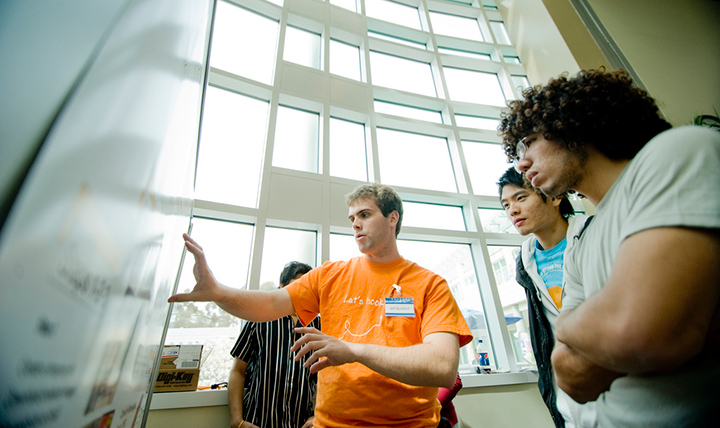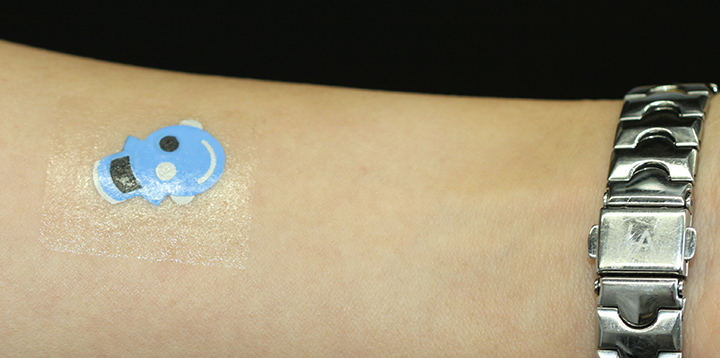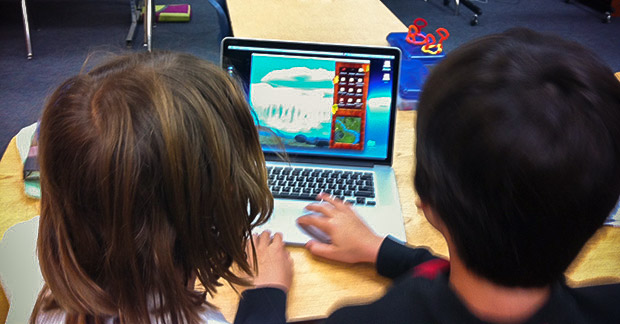
By:
- Daniel Kane
Published Date
By:
- Daniel Kane
Share This:
Want to See the Future? Attend Research Expo
Time machines? Not yet. But at Research Expo on April 18, you can talk to Jacobs School of Engineering graduate students who are working on the future. They’ll present advances on tattoo sensors for health monitoring, fire-fighting robots, solar forecasting, video games designed to teach computer programming, new materials for protecting soldiers from blasts, and much more.

Photo by Erik Jepsen/UC San Diego Publications
“Solving the world’s most pressing and complex challenges–in the realms of health, energy, information technology and other disciplines–requires research teams with a broad range of expertise working together. Research Expo is a showcase of the collaborations occurring every day on campus,” said UC San Diego Chancellor Pradeep K. Khosla.
Admission is free for UC San Diego faculty, students and staff, but registration is requested. Research Expo is April 18 at the Price Center on campus.
“The Research Expo poster session provides an excellent opportunity to meet more than 200 graduate students all in one afternoon. To give the campus community the opportunity to connect with some our newest faculty, six recent hires will give ten-minute talks covering advances in new materials, medicine, computing and earthquake engineering,” said Juan C. Lasheras, interim dean of the Jacobs School of Engineering.
At the poster session, you’ll be rubbing elbows with a high-powered group of attendees –many of whom are alumni–including the more than 100 engineers and technologists who serve as poster judges.
“I’m astonished every year at how advanced the research is,” said UC San Diego alumnus William Proffer, '76, '78 M.S Applied Mechanics, a longtime Research Expo judge. Proffer is assistant vice president for technology and Chief Systems Engineer for Science Applications International (SAIC) in La Jolla.
“For practicing scientists and engineers, Research Expo offers a refreshing view of what is current,” Proffer said.
This year, for the first time, the more than 200 engineering graduate student posters are tagged by industry application area, as well as department and keyword. For example, the “life sciences / medical devices & instruments” filter returns 49 posters from all six of the Jacobs School’s academic departments, as well as posters from graduate students with advisors from biological sciences, the School of Medicine and the Skaggs School of Pharmacy and Pharmaceutical Sciences.
Research Expo posters include:
Nanofoams for Better Blast Protection

Porous silica, with an average pore size of a few microns seen at the 5-micron, 20-micron and 50-micron scale.
Structural engineers are developing nanofoams that could be used to make better body armor; prevent traumatic brain injury and blast-related lung injuries in soldiers; and protect buildings from impacts and blasts. It’s the first time researchers are investigating the use of nanofoams for structural protection. Learn more.
Tattoos to Measure Stamina

By integrating complex electrochemical sensors with simple, fairground tattoos, nanoengineers have created a highly sensitive, wearable biosensor that monitors electrolyte and metabolite levels in sweat to assess the metabolic health of a patient, and, in particular, their stamina. The temporary electrochemical tattoo relies on a carbon fiber backbone so that it bends with the skin during normal activity without loss of functionality as well as a conductive polymer that is sensitive to pH-levels in sweat. Learn more.
New Optical Waveguide
Information systems now rely primarily on fiber optic networks to connect and share data around the world using photons instead of electrons, but the underlying computer technology is still based on electronic chips. Researchers are hard at work developing on-chip optical networking devices such as optical waveguides, switches, and amplifiers. Electrical engineering graduate student Andrew Grieco is developing a new type of optical waveguide that promises to improve efficiency and reduce power consumption. Learn more.

After just one hour of play, children master some of Java’s basic components.
Code Magic Spells. Learn Java.
Computer scientists have developed an immersive, first-person player video game designed to teach students elementary-age and above how to program in Java, one of the most common programming languages in use today. The researchers tested the game on a group of 40 girls, ages 10 to 12, who had never been exposed to programming before. They found that within just one hour of play, the girls had mastered some of Java’s basic components and were able to use the language to create new ways of playing with the game. The UC San Diego computer scientists plan to release the game for free and make it available to any educational institution that requests it. Researchers are currently conducting further case studies in local San Diego elementary schools. Watch a Code Spells video here.
Corporate sponsors for Research Expo include: Qualcomm, ViaSat and SAIC. Research Expo is a program of the Jacobs School’s Corporate Affiliates Program.
Share This:
You May Also Like
Stay in the Know
Keep up with all the latest from UC San Diego. Subscribe to the newsletter today.


